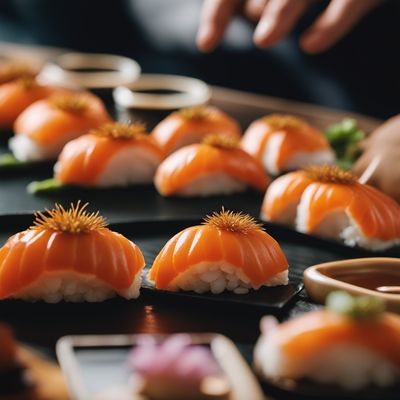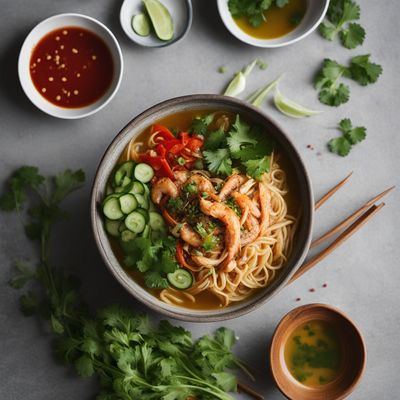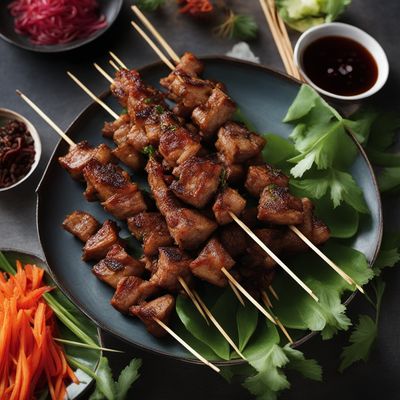
Recipe
Burmese Chinese Style Steamed Egg Custard
Silky Delight: Burmese Chinese Steamed Egg Custard
4.6 out of 5
Indulge in the delicate flavors of Burmese Chinese Style Steamed Egg Custard. This dish combines the smoothness of Japanese Chawanmushi with the vibrant spices and ingredients of Burmese Chinese cuisine.
Metadata
Preparation time
15 minutes
Cooking time
20 minutes
Total time
35 minutes
Yields
4 servings
Preparation difficulty
Easy
Suitable for
Low-carb, Gluten-free, Dairy-free, Nut-free, Pescatarian
Allergens
Eggs, Soy
Not suitable for
Vegan, Vegetarian, Paleo, Keto, Halal
Ingredients
In this adaptation, the traditional Japanese Chawanmushi is transformed into a Burmese Chinese delight. The original dish's simplicity is enhanced by incorporating Burmese Chinese spices and ingredients, resulting in a more robust and flavorful custard. The toppings are also modified to reflect the vibrant and colorful nature of Burmese Chinese cuisine. We alse have the original recipe for Chawanmushi, so you can check it out.
-
4 large eggs 4 large eggs
-
1 cup (240ml) chicken broth 1 cup (240ml) chicken broth
-
1 tablespoon soy sauce 1 tablespoon soy sauce
-
1 tablespoon oyster sauce 1 tablespoon oyster sauce
-
1 teaspoon fish sauce 1 teaspoon fish sauce
-
1 teaspoon sesame oil 1 teaspoon sesame oil
-
1/2 teaspoon ground white pepper 1/2 teaspoon ground white pepper
-
1/2 teaspoon garlic powder 1/2 teaspoon garlic powder
-
1/2 teaspoon ginger powder 1/2 teaspoon ginger powder
-
1/4 teaspoon turmeric powder 1/4 teaspoon turmeric powder
-
1/4 teaspoon chili powder 1/4 teaspoon chili powder
-
1/4 cup (30g) diced carrots 1/4 cup (30g) diced carrots
-
1/4 cup (30g) diced bell peppers (assorted colors) 1/4 cup (30g) diced bell peppers (assorted colors)
-
1/4 cup (30g) diced mushrooms 1/4 cup (30g) diced mushrooms
-
1/4 cup (30g) diced spring onions 1/4 cup (30g) diced spring onions
-
1/4 cup (30g) diced cilantro 1/4 cup (30g) diced cilantro
Nutrition
- Calories (kcal / KJ): 180 kcal / 753 KJ
- Fat (total, saturated): 10g, 3g
- Carbohydrates (total, sugars): 7g, 2g
- Protein: 15g
- Fiber: 1g
- Salt: 1.5g
Preparation
-
1.In a mixing bowl, whisk together the eggs, chicken broth, soy sauce, oyster sauce, fish sauce, sesame oil, ground white pepper, garlic powder, ginger powder, turmeric powder, and chili powder.
-
2.Strain the egg mixture through a fine-mesh sieve to ensure a smooth custard texture.
-
3.Divide the diced carrots, bell peppers, mushrooms, spring onions, and cilantro equally among four heatproof bowls or ramekins.
-
4.Pour the egg mixture over the vegetables in each bowl.
-
5.Place the bowls in a steamer and cover with a lid.
-
6.Steam over medium heat for approximately 15-20 minutes, or until the custard is set but still slightly jiggly in the center.
-
7.Remove the bowls from the steamer and let them cool for a few minutes before serving.
-
8.Garnish each custard with additional diced vegetables and cilantro, if desired.
Treat your ingredients with care...
- Eggs — Make sure to strain the egg mixture to achieve a smooth custard texture.
- Chicken broth — Use low-sodium chicken broth to control the saltiness of the dish.
- Soy sauce — Opt for a gluten-free soy sauce if following a gluten-free diet.
- Oyster sauce — Check the label to ensure it is free from any allergens or additives.
- Fish sauce — Use a high-quality fish sauce for the best flavor.
Tips & Tricks
- For a richer flavor, you can add a few drops of sesame oil to the custard mixture before steaming.
- Customize the toppings by adding your favorite vegetables or proteins such as shrimp or diced chicken.
- To achieve a smooth custard texture, strain the egg mixture twice.
- Serve the custard warm or at room temperature for the best taste and texture.
- Experiment with different spice levels by adjusting the amount of chili powder to suit your preference.
Serving advice
Serve the Burmese Chinese Style Steamed Egg Custard as an appetizer or a light main course. It pairs well with steamed rice or noodles.
Presentation advice
Present the custard in individual bowls or ramekins, garnished with colorful diced vegetables and cilantro. The vibrant toppings will enhance the visual appeal of the dish.
More recipes...
For Japanese cuisine » Browse all
For Burmese Chinese cuisine » Browse all
More Japanese cuisine dishes » Browse all

Sashimi
Sashimi is a Japanese dish made by thinly slicing raw fish and serving it with soy sauce and wasabi. It is a popular dish in Japanese cuisine and...

Kaisendon
Kaisendon is a Japanese rice bowl dish that is topped with various types of sashimi (raw fish) and other seafood. It is a popular dish in Japan...

Uni nigiri sushi
Sea Urchin Nigiri
Uni nigiri sushi is a traditional Japanese dish that consists of a small ball of sushi rice topped with a slice of fresh sea urchin. It is a...









